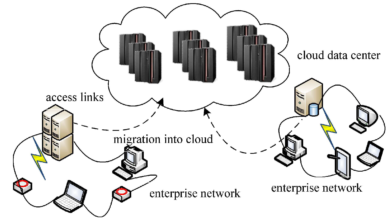Workflow Optimization with Data Servers
In today’s fast-paced digital world, businesses are constantly striving to find ways to optimize their workflow processes. One powerful tool that has revolutionized the way organizations handle data is data servers. These robust systems not only store and manage vast amounts of information but also play a crucial role in streamlining operations for maximum efficiency. In this blog article, we will delve into the world of workflow optimization with data servers, exploring the benefits they offer and how they can be leveraged to drive success in your organization.
First and foremost, it is essential to understand the concept of workflow optimization. By definition, it refers to the process of enhancing the efficiency and effectiveness of a workflow. This involves identifying bottlenecks, eliminating redundancies, and streamlining tasks to ensure seamless operations. Data servers serve as the backbone of this optimization journey, providing the infrastructure and tools necessary to achieve these goals.
Understanding Data Servers and Their Role in Workflow Optimization
Data servers are powerful systems that store, manage, and process vast amounts of data for organizations. They serve as the central hub for information, ensuring that data is readily accessible, secure, and efficiently managed. There are various types of data servers, each catering to specific needs and functionalities within an organization.
File Servers: Efficient Data Storage and Access
File servers are designed to store and manage files, making them easily accessible to authorized users. These servers provide a centralized location where employees can store and retrieve documents, ensuring that the latest version is always available. With file servers, workflow optimization is achieved by eliminating the need for manual file sharing and reducing the risk of data loss or duplication.
Database Servers: Organized Data Management
Database servers are specifically designed to manage large volumes of structured data. They provide a structured framework for storing and retrieving data, ensuring data integrity and consistency. With database servers, organizations can optimize their workflow by efficiently managing and organizing data, facilitating seamless access, and enabling efficient data analysis and reporting.
Application Servers: Streamlining Business Processes
Application servers play a crucial role in workflow optimization by hosting and managing applications that support business processes. These servers handle the processing and logic required to deliver data and services to end-users. By offloading application processing to dedicated servers, organizations can ensure efficient handling of requests, reduce response times, and enhance overall workflow efficiency.
Assessing Workflow Challenges and Identifying Areas for Improvement
Before embarking on the journey of workflow optimization, it is crucial to assess the current state of your workflow and identify areas that need improvement. This assessment helps uncover bottlenecks, redundancies, and inefficiencies that hinder productivity and effectiveness. By understanding the challenges, organizations can strategize and implement targeted solutions to optimize their workflow.
Communication Gaps: Bridging the Divide
One common challenge in workflow optimization is communication gaps. Inefficient communication can lead to delays, errors, and misunderstandings, ultimately impacting productivity. By identifying the communication gaps within your workflow, such as reliance on email or outdated communication tools, organizations can implement data servers that offer real-time messaging and collaboration capabilities. These features enable seamless communication, ensuring that teams can easily exchange information, ask questions, and collaborate effectively, ultimately enhancing workflow efficiency.
Data Overload: Managing and Processing Efficiently
In today’s data-driven world, organizations often face the challenge of managing and processing vast amounts of information. Data overload can lead to inefficiencies, delays, and errors in workflow processes. To overcome this challenge, organizations can leverage data servers that provide robust data management capabilities. These servers enable organizations to efficiently store, categorize, and retrieve data, ensuring that it is readily accessible when needed. Additionally, data servers offer features such as data deduplication, compression, and indexing, allowing organizations to optimize storage space and enhance data processing efficiency.
Repetitive and Manual Tasks: Automating for Efficiency
Another common challenge in workflow optimization is the presence of repetitive and manual tasks that consume valuable time and resources. These tasks not only impede productivity but also increase the risk of errors. Data servers offer powerful automation capabilities that can streamline these tasks, freeing up time for employees to focus on more value-added activities. By automating repetitive processes, organizations can eliminate errors, reduce lead times, and enhance overall workflow efficiency.
Implementing Data Servers to Streamline Communication and Collaboration
Efficient communication and collaboration are vital components of any successful workflow. Data servers can play a significant role in streamlining these aspects, enabling teams to communicate effectively and collaborate seamlessly.
Real-time Messaging: Instant Communication and Feedback
Real-time messaging capabilities offered by data servers allow employees to communicate instantly, regardless of their physical location. This feature eliminates the need for lengthy email chains or delays in response, enabling quick decision-making and problem-solving. Real-time messaging also facilitates immediate feedback, ensuring that teams can collaborate efficiently and resolve issues promptly, ultimately enhancing workflow efficiency.
File Sharing and Document Collaboration: Streamlined Workflows
Data servers provide robust file sharing and document collaboration features, eliminating the need for manual file transfers and version control. With data servers, multiple team members can work on the same document simultaneously, making real-time changes and updates. This streamlines workflows, ensures that everyone has access to the latest version of a document, and reduces the risk of errors or duplications.
Virtual Meeting Spaces: Seamless Collaboration
Data servers also offer virtual meeting spaces, where team members can collaborate in real-time through audio and video conferencing. These virtual meeting spaces enable effective communication, regardless of geographical locations, fostering collaboration and enhancing workflow efficiency. By leveraging these capabilities, organizations can eliminate the need for physical meetings, reducing travel costs and saving valuable time.
Leveraging Data Servers for Centralized Data Management and Accessibility
Efficient data management is a core aspect of workflow optimization. Data servers play a crucial role in facilitating centralized data management and ensuring that information is easily accessible to authorized users.
Centralized Data Storage: Easy Access and Organization
Data servers provide a centralized location for storing and organizing data, ensuring that all relevant information is readily accessible. This centralized approach eliminates the need for employees to search through multiple systems or locations to find the data they need, reducing time wastage and improving overall workflow efficiency. With data servers, organizations can implement a standardized data storage structure, making it easier for employees to find the information they need quickly.
Version Control: Avoiding Data Duplication and Confusion
Data servers offer robust version control capabilities, ensuring that only the latest version of a document or file is accessible to users. This feature avoids confusion and minimizes the risk of data duplication or outdated information. By leveraging version control in data servers, organizations can streamline their workflow, ensuring that everyone is working with the most up-to-date data, ultimately enhancing productivity and reducing errors.
Data Security: Protecting Sensitive Information
Data security is a critical consideration in workflow optimization. Data servers provide robust security features, such as encryption, access controls, and user authentication, to ensure that sensitive information is protected from unauthorized access. These security measures not only safeguard data but also contribute to regulatory compliance. By leveraging data servers for secure data management, organizations can optimize their workflow while maintaining the highest level of data protection.
Enhancing Workflow Efficiency with Automated Processes and Workflows
Automating repetitive tasks and workflows is a key strategy for workflow optimization. Data servers offer powerful automation capabilities that can significantly enhance workflow efficiency.
Workflow Automation: Streamlining Processes
Data servers enable organizations to automate various workflow processes, eliminating manual interventions and reducing the risk of errors. Workflow automation involves defining a series of tasks and actions that are triggered based on predefined conditions. By automating workflows, organizations can ensure that tasks are executed consistently and efficiently, reducing lead times and optimizing overall workflow performance.
Task Scheduling: Efficient Resource Allocation
Data servers provide task scheduling capabilities, allowing organizations to allocate resources efficiently and ensure that tasks are completed within the desired timeframe. With task scheduling, organizations can prioritize and assign tasks based on their urgency and importance, optimizing resource allocation and enhancing workflow efficiency.
Data Integration: Seamless Data Exchange
Data servers enable seamless integration with other systems and applications, facilitating the exchange of data between different platforms. By integrating data servers with existing tools and systems, organizations can eliminate manual data entry and ensure that information flows seamlessly between systems. This integration enhances workflow efficiency by reducing errors, minimizing data duplication, and streamlining data exchange processes.
Ngadsen test2
Optimizing Performance and Scalability with Data Servers
As organizations grow and expand, it is crucial to ensure that the underlying infrastructure can handle increased demands. Data servers offer performance optimization and scalability features that can support the evolving needs of an organization.
Load Balancing: Efficient Resource Distribution
Data servers provide load balancing capabilities, ensuring that resources are distributed efficiently across multiple servers or nodes. Load balancing optimizes performance by preventing any single server from becoming overloaded, thereby maintaining high availability and responsiveness. By leveraging load balancing features, organizations can optimize their workflow by ensuring that data servers can handle increased demands without compromising performance.
Caching: Accelerating Data Access
Data servers offer caching capabilities, enabling frequently accessed data to be stored in memory forfaster retrieval. Caching significantly improves data access speeds, reducing latency and enhancing workflow efficiency. By leveraging caching features in data servers, organizations can optimize their workflow by ensuring that commonly accessed data is readily available, resulting in faster response times and improved overall performance.
Scalability Options: Adapting to Growing Needs
Data servers provide scalability options that allow organizations to seamlessly expand their infrastructure as their needs grow. Scalability ensures that data servers can handle increased workloads and accommodate growing amounts of data without compromising performance. By leveraging scalability features, organizations can optimize their workflow by ensuring that their data servers can scale up or out to meet the evolving demands of their operations.
Ensuring Data Security and Compliance with Data Servers
Data security and compliance are paramount considerations in today’s digital landscape. Data servers offer robust security features that enable organizations to protect their sensitive information and ensure compliance with regulations.
Encryption: Safeguarding Data from Unauthorized Access
Data servers provide encryption capabilities, ensuring that data is securely stored and transmitted. Encryption converts data into an unreadable format, which can only be deciphered with the appropriate encryption key. By leveraging encryption in data servers, organizations can optimize their workflow by safeguarding sensitive data from unauthorized access, reducing the risk of data breaches, and enhancing overall data security.
Access Controls: Restricting Data Access to Authorized Users
Data servers offer robust access control mechanisms, allowing organizations to define and enforce user permissions and restrictions. Access controls ensure that only authorized individuals can access specific data or perform certain actions. By implementing access controls in data servers, organizations can optimize their workflow by reducing the risk of unauthorized data access, maintaining data confidentiality, and ensuring compliance with data privacy regulations.
Audit Trails: Tracking Data Access and Modifications
Data servers provide audit trail capabilities, which record and track all activities related to data access and modifications. Audit trails enable organizations to monitor and review data usage, providing an additional layer of security and ensuring compliance with regulatory requirements. By leveraging audit trail features in data servers, organizations can optimize their workflow by maintaining data integrity, identifying any unauthorized access or modifications, and facilitating forensic investigations if necessary.
Monitoring and Analyzing Workflow Performance with Data Servers
Continuous monitoring and analysis are essential for identifying areas of improvement in workflow optimization. Data servers offer monitoring and analytics features that enable organizations to gain insights into their workflow performance and make data-driven decisions.
Performance Monitoring: Identifying Bottlenecks and Inefficiencies
Data servers provide performance monitoring capabilities, allowing organizations to monitor various parameters such as CPU usage, memory utilization, and network traffic. Performance monitoring enables organizations to identify bottlenecks and inefficiencies in their workflow, helping them make informed decisions to optimize performance. By leveraging performance monitoring features in data servers, organizations can proactively address issues, streamline processes, and enhance overall workflow efficiency.
Log Analysis: Extracting Valuable Insights
Data servers generate logs that capture detailed information about system activities, errors, and user interactions. Log analysis tools enable organizations to extract valuable insights from these logs, helping them identify patterns, detect anomalies, and troubleshoot issues. By leveraging log analysis capabilities in data servers, organizations can optimize their workflow by gaining a deeper understanding of their system’s performance, identifying areas for improvement, and enhancing overall efficiency.
Reporting: Visualizing Workflow Performance
Data servers offer reporting features that allow organizations to generate visual reports and dashboards to monitor and analyze workflow performance. These reports provide a comprehensive view of key metrics, enabling organizations to track progress, identify trends, and make data-driven decisions. By leveraging reporting capabilities in data servers, organizations can optimize their workflow by visualizing performance metrics, identifying areas of improvement, and communicating progress effectively.
Integrating Data Servers with Existing Workflow Tools and Systems
Most organizations already have a suite of tools and systems in place to manage their workflow. Data servers offer integration capabilities that allow seamless integration with existing tools, ensuring streamlined workflows and efficient data exchange.
Project Management Software Integration: Streamlining Project Workflows
Data servers can be integrated with project management software, allowing organizations to centralize project-related data and streamline project workflows. By integrating data servers with project management software, organizations can optimize their workflow by ensuring that project documents, tasks, and communications are seamlessly integrated, facilitating collaboration, and enhancing project efficiency.
CRM System Integration: Enhancing Customer Workflows
Data servers can be integrated with Customer Relationship Management (CRM) systems, enabling organizations to centralize customer-related data and streamline customer workflows. By integrating data servers with CRM systems, organizations can optimize their workflow by ensuring that customer data, interactions, and activities are seamlessly integrated, improving customer service, and enhancing overall workflow efficiency.
Collaboration Platform Integration: Enabling Seamless Collaboration
Data servers can be integrated with collaboration platforms, such as document management systems or team collaboration tools. This integration allows organizations to centralize data and streamline collaboration workflows. By integrating data servers with collaboration platforms, organizations can optimize their workflow by ensuring that team members can access and collaborate on documents and files efficiently, improving communication, and enhancing overall workflow efficiency.
Future Trends and Innovations in Workflow Optimization with Data Servers
The landscape of workflow optimization with data servers is continually evolving, with new trends and innovations emerging. Organizations can stay ahead of the curve by embracing these advancements and leveraging them to further enhance workflow efficiency.
Artificial Intelligence and Machine Learning: Intelligent Workflow Automation
Artificial Intelligence (AI) and Machine Learning (ML) technologies are revolutionizing workflow optimization. AI and ML algorithms can analyze vast amounts of data, identify patterns, and make intelligent decisions to automate and optimize workflows. By leveraging AI and ML capabilities in data servers, organizations can achieve intelligent workflow automation, further enhancing efficiency, and driving productivity.
Predictive Analytics: Proactive Workflow Optimization
Predictive analytics uses historical data and statistical models to make predictions about future events or trends. By leveraging predictive analytics capabilities in data servers, organizations can gain insights into potential workflow bottlenecks, identify areas for improvement, and proactively optimize their workflows. Predictive analytics empowers organizations to make data-driven decisions and take proactive measures to enhance workflow efficiency.
Cloud Integration: Scalability and Flexibility
Cloud integration is a growing trend in workflow optimization. By integrating data servers with cloud platforms, organizations can leverage the scalability and flexibility offered by cloud computing. Cloud integration enables organizations to scale their infrastructure as needed, access data from anywhere, and collaborate seamlessly. By embracing cloud integration, organizations can optimize their workflow by harnessing the power of the cloud and adapting to changing business needs.
In conclusion, workflow optimization with data servers is a game-changer for organizations seeking to maximize efficiency and drive success. By understanding the functionalities, challenges, and benefits of data servers, organizations can leverage them to streamline communication, enhance data management, automate processes, ensure security and compliance, monitor performance, integrate with existing systems, and embrace future trends. By embracing these strategies, organizations can unlock their full potential and gain a competitive edge in today’s dynamic business landscape.



